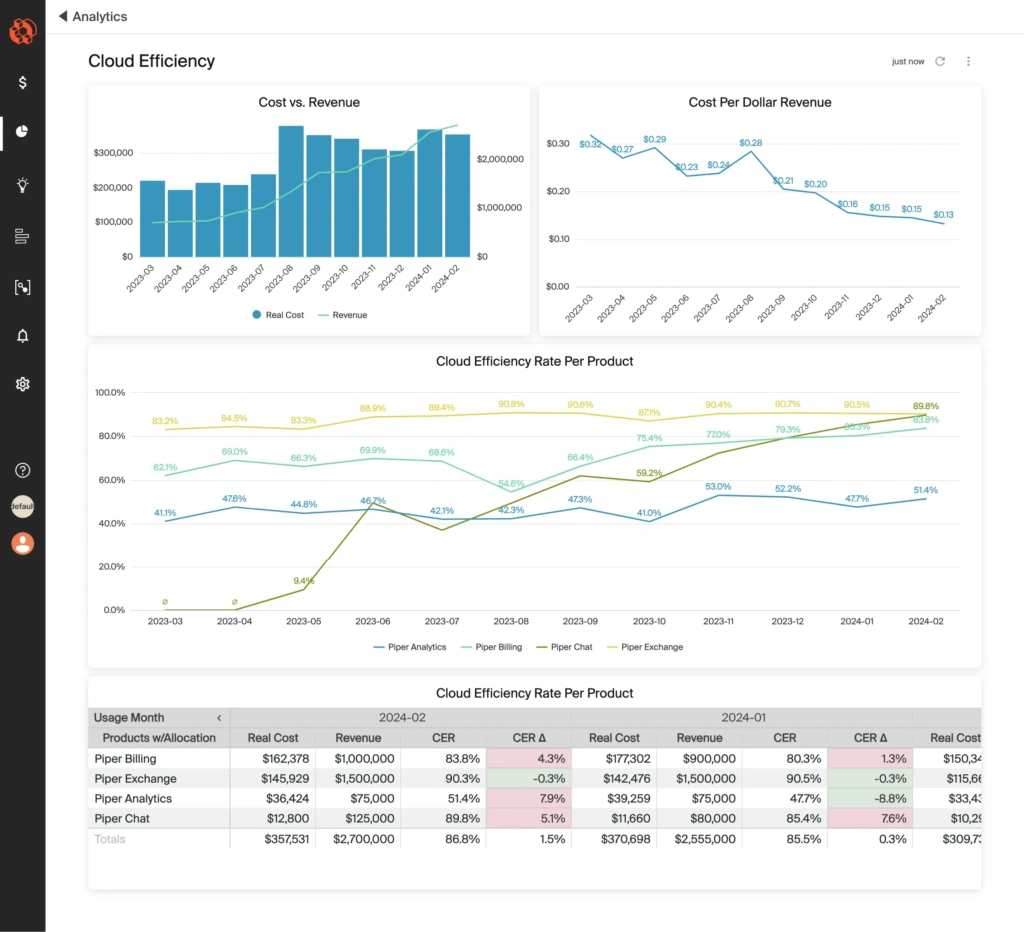In the last couple years, the SaaS world has undergone a paradigm shift with regard to cloud spending.
As macroeconomic conditions shift from “peachy” to “moldy,” as SaaS grows increasingly crowded, as company valuations face new pressure, and as venture funding cools down, companies are looking to reduce — or in industry jargon, “optimize” — their cloud spending as much as possible, as soon as possible.
For years, SaaS companies could write off mounting cloud bills as the cost of staying competitive. Now, SaaS companies face pressure to get efficient in the cloud, and fast.
Amid this shift, one thing about the cloud has remained unflinchingly true:
The cloud is an investment center like any other.
The cloud is something you spend money on so that your business can provide value at a lower cost than the cost at which it sells that value.
Like a car company would their factory, like a baseball team would its stadium, you should interrogate your costs to do business in the cloud, assess whether your cloud costs are growing at a healthy rate, and if they aren’t, pick the most impactful ways to optimize them.
These are the principles and capabilities on which CloudZero was founded. Our entire existence depends on delivering these outcomes to our customers, and we do it through the most sophisticated cost management platform on the market.
But it’s not just what our platform does — it’s our organizational philosophy that sets us apart. We’ve worked with enough of the world’s leading digital-native brands to know that the goal isn’t to keep cloud costs as low as possible; it’s to maximize cloud efficiency.
It’s to get as much value from every cloud dollar as possible, increasing and decreasing your cloud investment intelligently, based on complete, real-time, layerable data.
As one more small step in the direction of this goal, we’re pioneering a new category of SaaS metric to help digital-native businesses evaluate their cloud efficiency: Cloud Efficiency Rate (CER).
In principle, CER is fairly straightforward — but like all things cloud, calculating it accurately and responding to it meaningfully takes a data platform of unparalleled granularity and power.
How Is CER Calculated?
Step 1: Cost per dollar of revenue
The first step in calculating your CER is to calculate a unit cost: cost per dollar of revenue. To get your overall cost per dollar of revenue, divide your total cloud costs by your total revenue, et voila, you’ve got it.
This is a calculation CloudZero can easily perform. We’re already equipped to ingest and allocate 100% of your cloud costs, and all we need is some basic revenue information in order to create a dashboard that automatically updates your cost per dollar of revenue.
So, for a very simple example:
- Company A’s annual revenue is $100M.
- Company A’s annual cloud costs are $20M.
- So, Company A’s cost per dollar of revenue is 0.2. For every 20 cents they spend in the cloud, they produce a dollar of revenue.
Step 2: Convert to percentage for CER
CER is about comparing how much of your revenue you keep against how much you send to your cloud providers. So, we take the unit cost calculated in step one and convert it into a percentage, which represents your CER.
- Company A’s cost per dollar of revenue is 0.2.
- Of every dollar they make in the cloud, they pay their cloud providers 20 cents (20%).
- So, their CER is 80%.
Another way to calculate CER:
(Revenue – Cloud Costs) / Revenue
… which tells you the percentage of your revenue you’re not sending to your cloud providers.
At this level, CER is a fairly simple metric. Don’t be deceived though; getting an accurate CER depends on having precisely accurate cloud spend data: 100% of your spend ingested by your cost management platform, normalized in a common data model, overlaid with business context, and allocated accurately. Sub-perfect allocation will result in a sub-perfect CER.
CER Vs. COGS, R&D OpEx, And Gross Margin
CER is distinguished from other SaaS metrics in a couple important ways: It excludes headcount (more important to finance leaders than engineering leaders) and it includes cloud spend from both R&D and production. Here’s how that compares to other key SaaS metrics.
- Cost Of Goods Sold (COGS). For SaaS companies, COGS includes cloud costs, but only those cloud costs associated with production — the cost to serve your customers. It doesn’t include cloud costs associated with R&D.
- R&D OpEx. R&D OpEx is just the opposite: It includes R&D cloud costs — the costs to build your product — but not the cost to deliver it to customers.
- Gross Margin. Gross margin is a crucially important SaaS metric (and one CloudZero is uniquely equipped to calculate). But it only includes COGS, not R&D OpEx, making it limited in the same way that COGS is limited. It also includes headcount, which is less relevant from an engineering perspective.
Fundamentally, your engineering teams are the ones driving cloud cost. CER strips out headcount, isolating 100% of your cloud costs, and putting it in the context of revenue. It enables your engineering org to answer the question: When we spend a dollar in the cloud, how much do we get back?
The Comparative Power Of CER
CER gets especially informative when compared in two different intervals — before and after the adoption of a cost management platform, say.
If, in the previous example, Company A had started with $27.2M of annual cloud spend (36% more than $20M in the initial example), and the same level of revenue, their CER would be a much less impressive 72.8%.
Showing such demonstrable efficiency improvement to investors, board members, or any other invested leaders can have a profound impact on the success of a career, a team, an organization, a company as a whole.
What’s A Good CER?
The true power of SaaS metrics is that they’re barometers for business health. The better your SaaS metrics, the better your valuation, and the more attractive your business becomes to investors, shareholders, acquirers, etc. So, the question naturally arises: What’s an objectively good CER?
CloudZero is currently in the process of establishing CER benchmarks. We’ve done some early research on our customer base, and have generated some insights based on our public customers (below). In the future, we’ll be adding more data from a broader and more diverse swath of digital- and cloud-native businesses.
That said, there are some interesting data points to report. Within the sampling of customers we analyzed:
- Minimum CER is 81%. This was the least cloud-efficient customer in our dataset.
- Maximum CER is ~100%. Numerous customers approached 100% CER — where their cloud spend was less than 1% of their revenue.
- Average CER is 95%. For context, all of the customers we analyzed are public companies, so this potentially gives an idea of elite CER.
Interesting CER Change Stories
There were a few standout stories of how these companies’ CER has changed during their time as CloudZero customers:
- Revenue ↑, Cloud Spend ↓. One customer’s revenue increased 7%, while their cloud spend decreased 9% — for a very healthy impact on their CER.
- Revenue 2x Cloud Spend. Another customer’s revenue grew at double the rate of their cloud spend in the eight-quarter interval we looked at.
- Revenue ↓, Cloud Spend ↓ more. One customer’s revenue decreased 6% in the eight-quarter interval — but their cloud spend decreased even more, by 14%.
Let’s Get Multidimensional: Per-Unit And Layered CER

Understanding your overall CER is a great first step. But alone, overall CER is about as useful to engineering initiatives as gross margin is to finance initiatives — it can give you a sense of your general efficiency status, but it can’t necessarily point you to the most impactful savings areas.
So, it’s necessary to go one — or several — steps further, into per-unit and layered CER calculations.
Per-Unit CER
One of CloudZero’s most profound differentiators is our ability to give customers accurate unit cost calculations — cost per team, per product, per feature, per microservice, per customer, etc. We base these calculations on both billing and usage data, giving our customers precision where other platforms give averages or estimates.
Let’s take an example that many of our customers at some point want: cost per customer. Cost per customer shows you exactly what each of your customers costs you in the cloud.
People are often surprised by what they see — that their biggest customers are unprofitable, that one segment costs substantially more than another segment, that customer costs tend to spike at a particular time of day — and use these revelations to make intelligent changes to their infrastructure.
With a precise understanding of how much cost each customer is driving, and organizational knowledge of how much revenue each customer is driving, you could calculate CER per customer.
Imagine Company A has two customers, both using Kubernetes and sharing an S3 bucket, but whose costs are accurately allocated thanks to CloudZero:
- Customer X has a contract of $1M/yr, and drives $700,000/yr of cloud cost
- Customer Y has a contract of $400k/yr, and drives $50,000/yr of cloud cost
Customer X’s CER is 30%, and Customer Y’s CER is a much friendlier 87.5%.
Taking it a step further, Company A could get an average CER by dividing their revenue by the total cost attributable to their customers, and then compare every individual customer’s CER against this figure.
This would reveal disparities of cloud efficiency, and illuminate the most impactful opportunities for Company A to strengthen overall business efficiency.
Layered CER
You can take CER to an additional level of depth by leveraging another of CloudZero’s core differentiators: the ability to layer different unit cost metrics on top of one another for extremely nuanced understandings of business value drivers.
One of our customers, Beamable, is a video game company. The same way AWS provides cloud infrastructure for software companies to build and run their apps, Beamable provides video game infrastructure for game designers to build and run their games.
Beamable wanted a very sophisticated unit cost metric, that required layering three separate unit costs: cost per service per game per customer. In other words, how much each of a particular customer’s game’s individual services cost. Our CS team developed some sophisticated allocation logic to deliver this to them.
With CER, they could connect these unit costs to revenue at each stage of the calculation. Beamable could see their CER per service per game per customer, and understand exactly how much business value each of their customers’ individual games’ services were driving.
Of course, as every business has a unique business value framework, the layering potential for unit costs and for CER is endless. Develop as many CER views as you want, and view your cloud-driven business value through any lens, at any time.
CloudZero Is The Only Platform To Both Calculate And Optimize CER
Our first priority when building CloudZero was to make it the most powerful, intuitive way to understand what was driving your cloud spend, and whether it was justified.
So, we developed an extremely efficient method of allocating your costs: Ingest 100% of your costs with AnyCost™, normalize all costs in a common data model, add business context by ingesting telemetry streams, and use CostFormation® to overcome tagging issues, container challenges, and shared infrastructure obstacles to allocate 100% of your spend.
Perfect allocation data is the only way to get perfect CER calculations.
If you have any omissions in your spend data — because of bad tagging, because of shared costs, because of containerized costs (none of which CloudZero struggles with) — your CER will be inaccurate, and you’ll misrepresent your business value to customers, investors, acquirers, market regulators, and whoever else might be interested.
Furthermore, CloudZero is the only platform to optimize your CER, through a process that puts engineers at the center of cost savings.
Precise, granular, layerable CER shows you where you need to direct your savings energy; features like Insights, Anomalies, and Explorer point your engineers directly at inefficient cloud infrastructure and resources.
Stop relying on crude estimates for how much business value your cloud investment is driving. Get precise, get layerable, get clear instructions on how to improve — and drive unprecedented levels of business efficiency.








